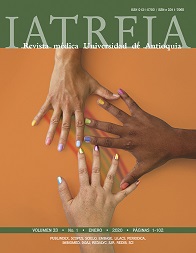The immunology in Antioquia: a history with future. I. The creation of a school
DOI:
https://doi.org/10.17533/udea.iatreia.39Keywords:
Antioquia, history, immunologyAbstract
Immunology is one of the biomedical sciences that had undergo, worldwide, a greater development in the last part of the XX century and the beginning of the XXI century. In Antioquia, immunology also had important developments that began the 1960s. In this historical review, the author who have actively participated in these developments in the Universidad de Antioquia, as an undergraduate and graduate student and later on as faculty member, describes the more significant local events and the role played by some distinguished faculty members in research, and in undergraduate and graduate teaching of immunology. The first part describes the historical events that occurred in the 1960 and 1970 decades that lead to the establishment of immunology as an independent biomedical.
Downloads
References
(1.) Klein J. Natural History of the Major Histocompatibility Complex. New York: John Wiley & Sons; 1986.
(2.) Escobar-Gónima C. La inmunología en Antioquia: primera parte. Iatreia. 2000;13:179-84.
(3.) Escobar-Gónima, C. La inmunología en Antioquia. Segunda Parte. Iatreia 2001;14:211-5.
(4.) Ehrlich P. The Croonian Lecture.-On Immunity with special reference to cell life. Proc Roy Soc London. 1997;66:424-48.
(5.) Burnet FM. A Modification of Jerne’s theory of antibody production using the concept of clonal selection. Austr J Sci. 1957;20:67-9.
(6.) Smith KA. Towards a molecular understanding of adaptive immunity: a chronology, part I. Front Immunol. 2012 Dec;3:369. DOI 10.3389/fimmu.2012.00369.
(7.) Smith KA. Towards a molecular understanding of adaptive immunity: a chronology, part II. Front Immunol. 2012;3:364. DOI 10.3389/fimmu.2012.00364.
(8.) Smith KA. Towards a molecular understanding of adaptive immunity: a chronology, part III. Front Immunol. 2014 Feb;5:29. DOI 10.3389/fimmu.2014.00029.
(9.) Salamanca Uribe J. Jorge Lleras Parra y la producción de la vacuna antivariólica en Colombia. Rev acad colomb cienc. 2004;28(109):545-54.
(10.) Kabat EA, Mayer MM. Experimental Immunochemistry. 3 ed. Springfield: Charles Thomas; 1958.
(11.) Restrepo M, de Restrepo F, Botero D. Reacciones serológicas en pacientes con amibiasis. Acta Med Colombiana 1976;4(1):223-8.
(12.) Restrepo A, Restrepo M, Ochoa N, Giraldo R. Comparación de la técnica de anticuerpos fluorescentes absorbidos (FTA-ABS) con el VDRL y la fijación del complemento (Reiter) en el serodiagnóstico de la sífilis. Antioquia Med. 1970;20:147-56.
(13.) Peña R, Restrepo M. Inmunoglobilina M en el diagnóstico de sífilis congénita. Antioquia Med. 1976;26:171-86.
(14.) Restrepo M, Bustamante A. Complemento sérico en individuos normales. Antioquia Med. 1972;22:617-24.
(15.) Restrepo M, Molina J, Aristizábal L, Agudelo, C. Niveles de complemento sérico total en varias entidades clínicas. Antioquia Med. 1974;24:35-46.
(16.) Restrepo M, Agudelo C, Molina J, Aristizábal L. Aplicación diagnóstica del Nitroazul de tretrazolium. Acta Med Colombiana. 1977;2:159-65.
(17.) Borrero RJ. Transplantes renales. Medellín: Bedout; 1977.
(18.) Arango L, García LF, Restrepo A. Mieloma de células plasmáticas: estudio de 44 casos. Antioquia Médica. 1975;25:569-89.
(19.) Arango L, Hidrón H, García LF. Macroglobulinemia de Waldenstrom. Antioquia Méd. 1976;26:253-7.
(20.) Restrepo A, Restrepo M, Maya LM, Pérez S. Valores de inmunoglobulinas séricas en leucemias y sus variaciones con la quimioterapia. Acta Med Colombiana 1976;1:121-7.
(21.) Restrepo J, Restrepo A, Bojanini E, Bustamante J, Restrepo M, Vélez H. Agamaglobulinemia adquirida primaria: presentación de un caso. Antioquia Med. 1965;15:53-66.
(22.) Restrepo A, Restrepo M, Maya LM. Neutropenia crónica familiar benigna. Acta Med Colombiana. 1977;2:11-8.
(23.) García LF. Linfocitos formadores de Rosetas en pacientes tuberculosos. [Tesis Maestría en Microbiología Médica]. Medellín: Universidad de Antioquia; 1974.
(24.) Munson D, Franco D, Arbeter A, Velez H, Vitale JJ.
Serum levels of immunoglobulins, cell-mediated immunity, and phagocytosis in protein-calorie malnutrition. Am J Clin Nutrit. 1974;27:625-8.
(25.) Restrepo A. La prueba de la inmunodifusión en el diagnóstico de la Paracoccidioidomicosis. Sabouraudia, 1966;4:223-30.
(26.) Restrepo MA, Vélez AH. Efectos de la fagocitosis in vitro sobre el Paracoccidioides brasiliensis. Sabourodia. 1975;13:10-21.
(27.) Jaramillo AC, Restrepo M, García LF. Comparación antigénica entre tres cepas de Toxoplasma gondii y una de Besnoitia jellisonii. Rev Latinoam Microbiol. 1976;18:93-6.
(28.) García-Moreno LF, Myrvik QN. Macrophage-Agglutinating Factor produced in vitro by BCG-sensitized lymphocytes. Infect Immunity.1977;17:613-20.
Published
How to Cite
Issue
Section
License
Copyright (c) 2019 Universidad de Antioquia

This work is licensed under a Creative Commons Attribution-NonCommercial-ShareAlike 4.0 International License.
Papers published in the journal are available for use under the Creative Commons license, specifically Attribution-NonCommercial-ShareAlike 4.0 International.
The papers must be unpublished and sent exclusively to the Journal Iatreia; the author uploading the contribution is required to submit two fully completed formats: article submission and authorship responsibility.














